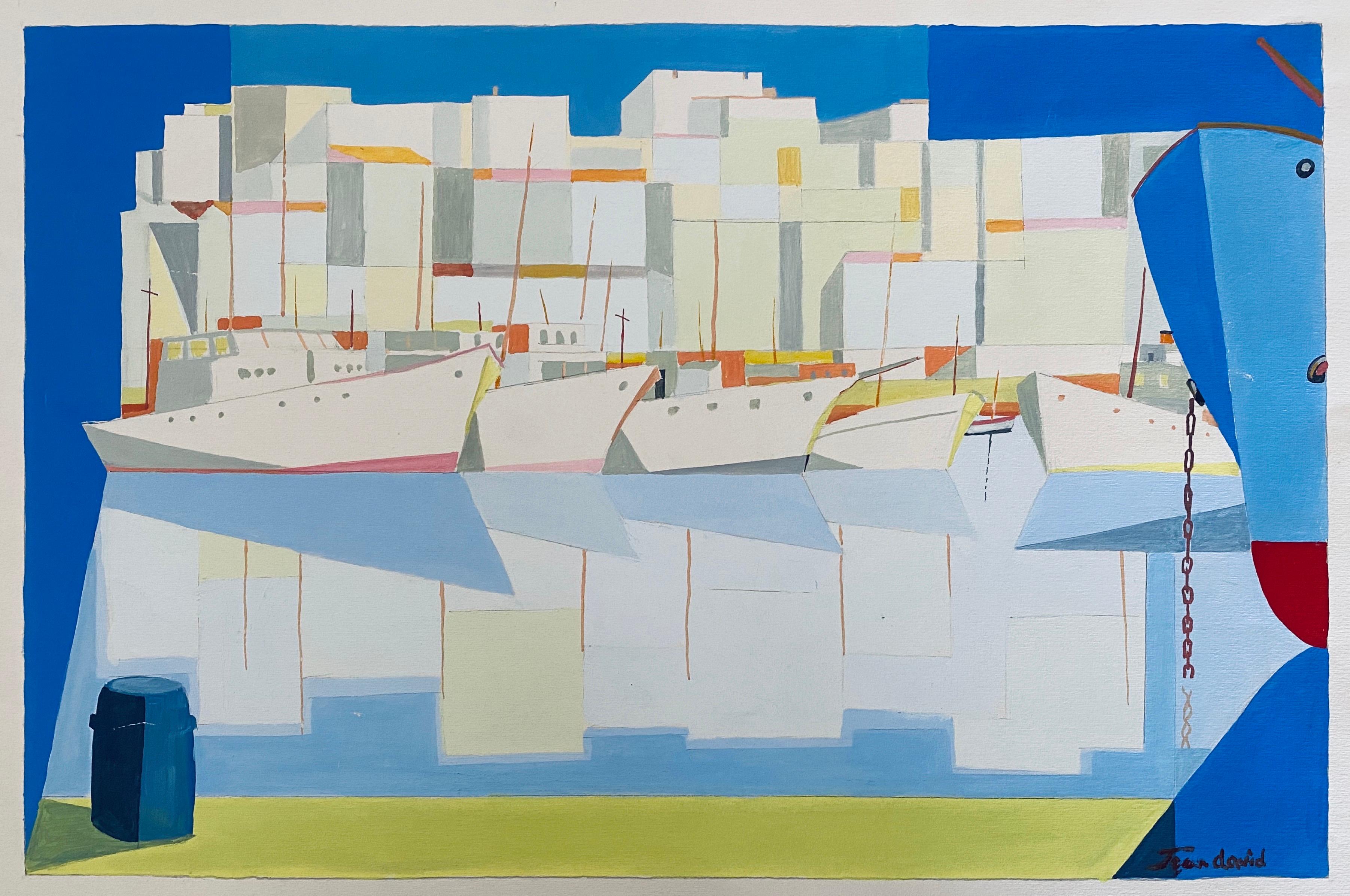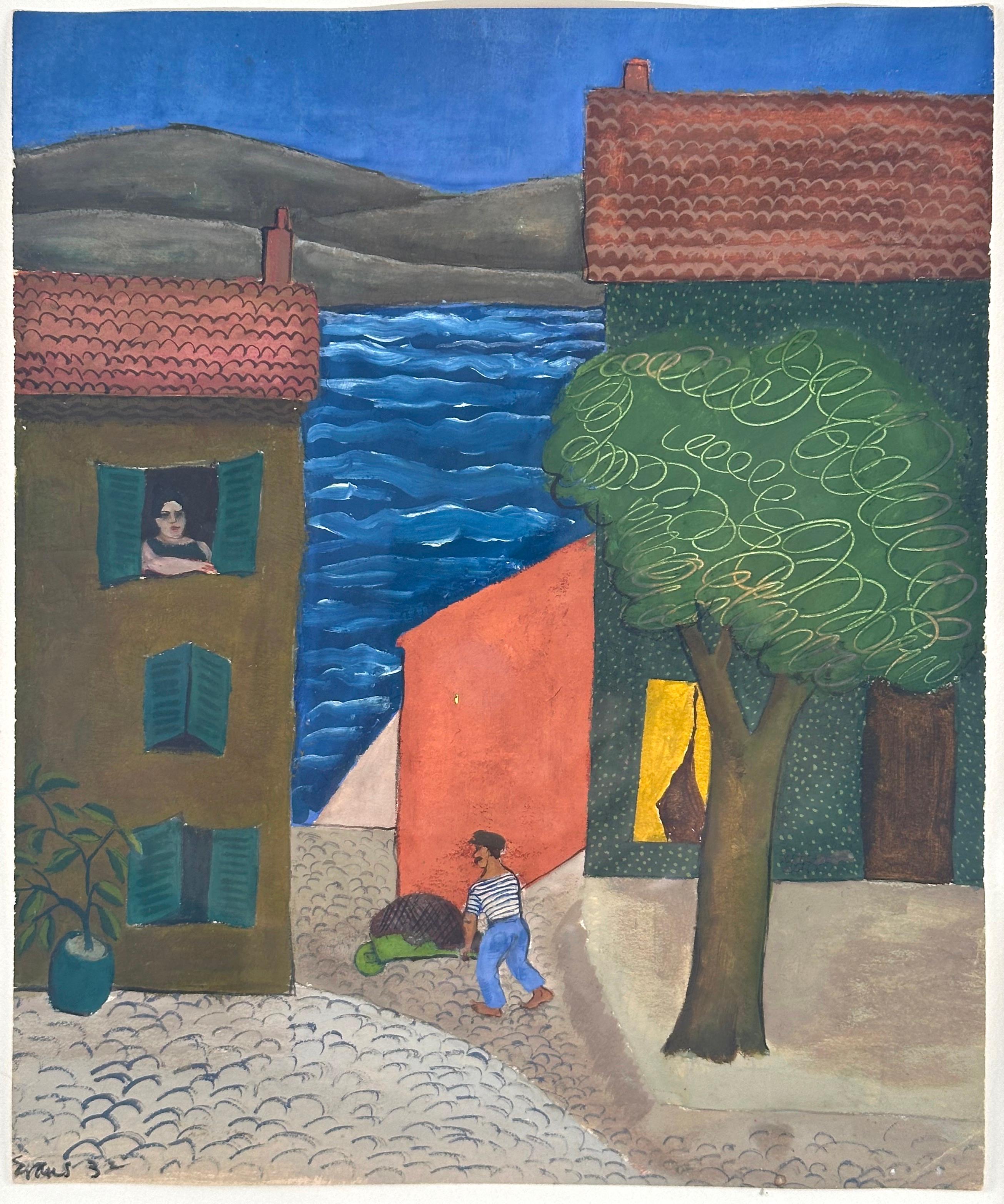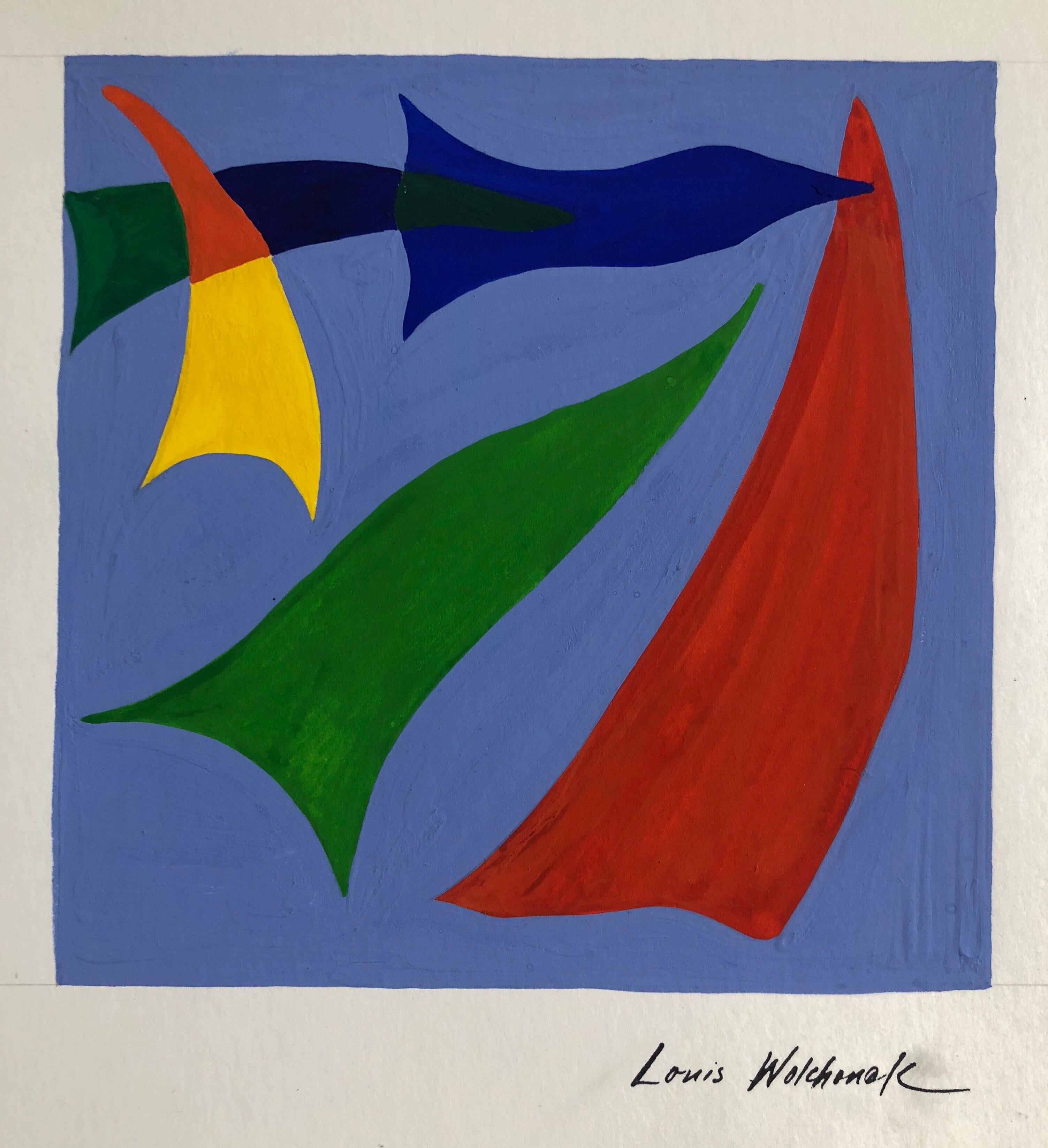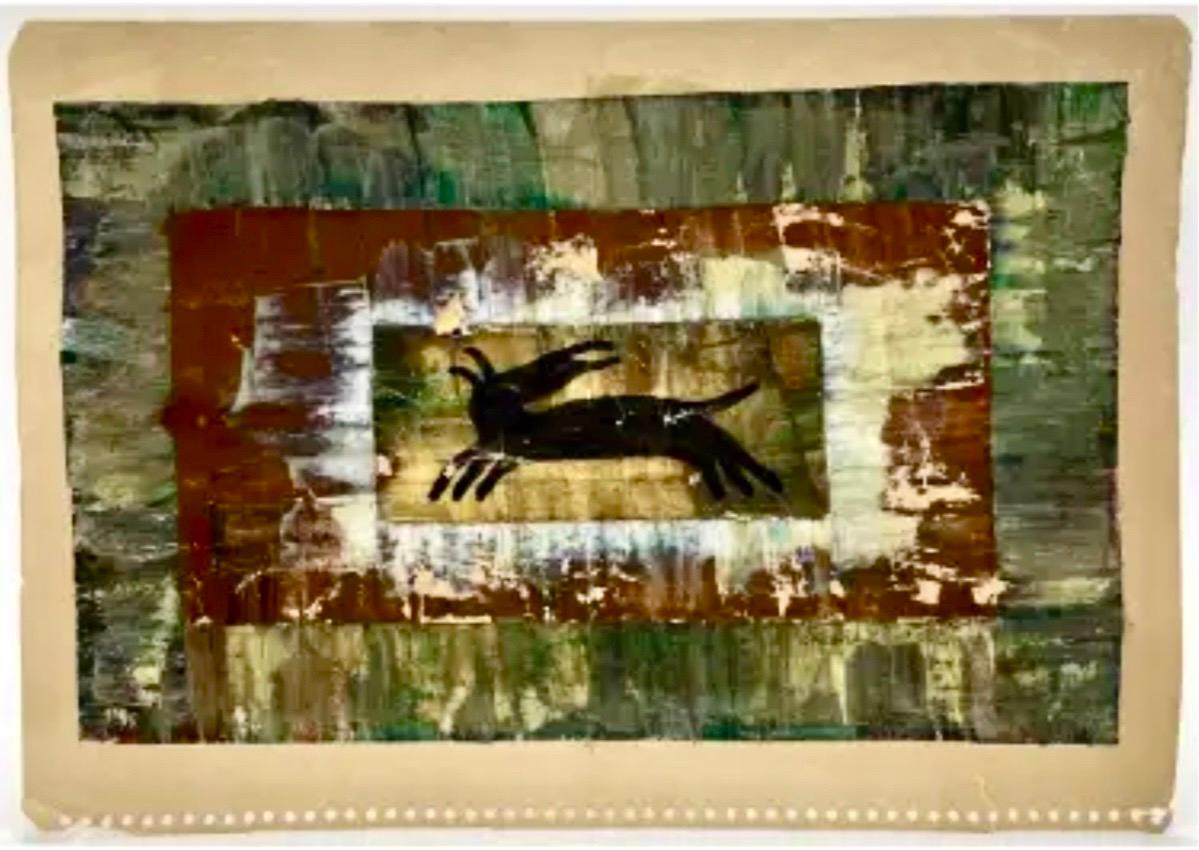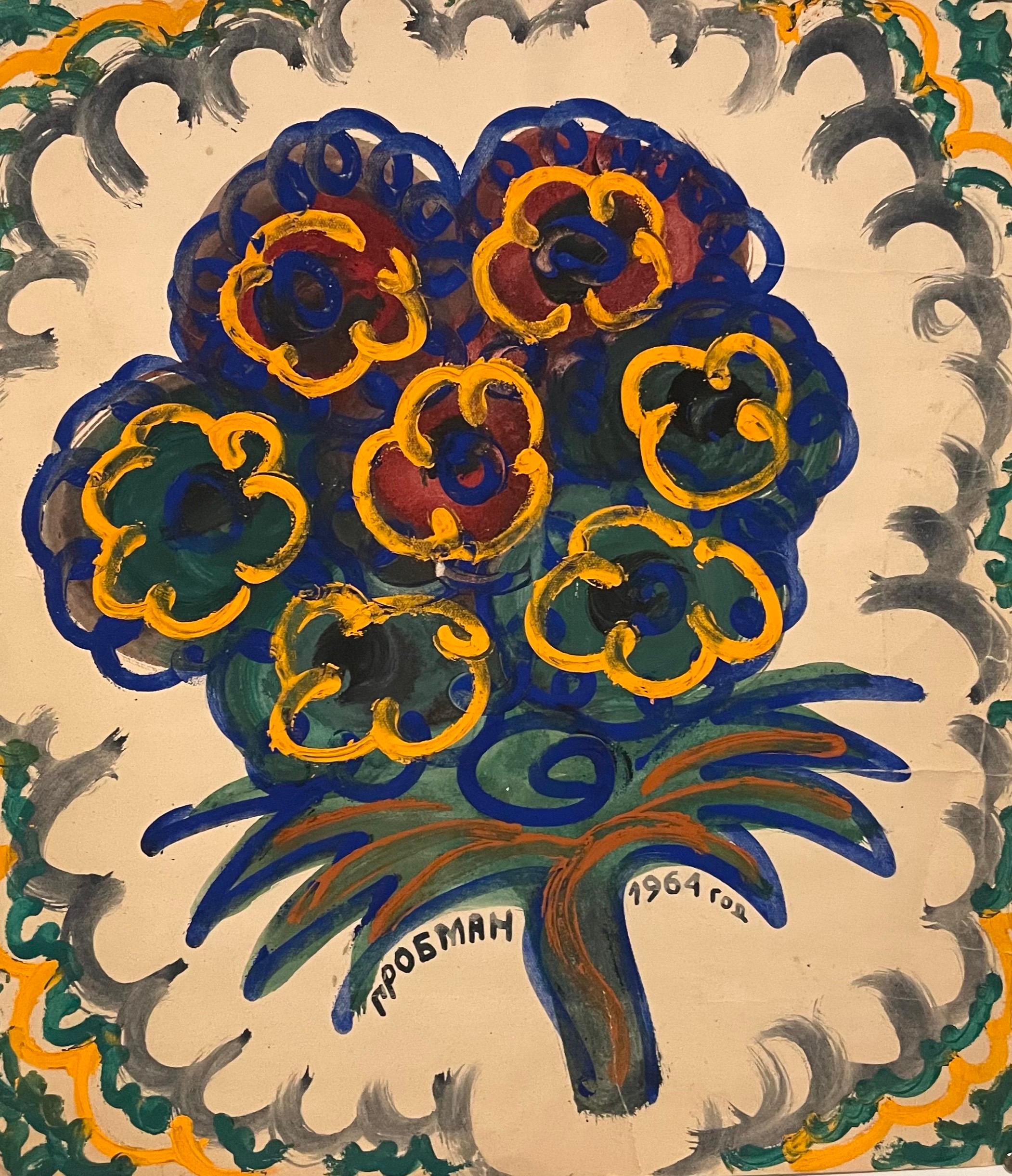Alexander CalderBowling, 19741974
1974
About the Item
- Creator:Alexander Calder (1898 - 1976, American)
- Creation Year:1974
- Dimensions:Height: 38.5 in (97.79 cm)Width: 52.25 in (132.72 cm)
- Medium:
- Movement & Style:
- Period:
- Condition:Generally very good condition - the corners of the sheet are soft; there are soft creases in the lower and upper left corners; faint time-staining consistent with age and some scattered spots of medium and accretions (inherent to the artist's working.
- Gallery Location:Greenwich, CT
- Reference Number:
Alexander Calder
The American sculptor Alexander Calder is known as the father of the mobile, a moving artwork composed of delicately balanced sculptural forms suspended from the ceiling.
Because Calder's parents, both artists themselves, did not want him to suffer the hardships of trying to make a living in art, they encouraged the young Calder to study mechanical engineering at the Stevens Institute of Technology, in Hoboken, New Jersey. He worked a number of jobs, including as a hydraulic engineer and draftsman for the New York Edison Company, before deciding to pursue an artistic career. He never abandoned his engineering background, however, applying his understanding of gears and moving parts in all his artworks, from mechanical toys like the Cirque Calder (1931) and his revered prints to his free-standing abstract sculptures, called stabiles.
In 1926, Calder moved to Paris and established a studio in the Montparnasse quarter. He began creating the many parts of his famous miniature circus from found materials, such as wire, string, cloth, rubber and cork. Designed to be transportable, Cirque grew to fill five suitcases over the years. Always interested in putting forms in motion, Calder also pioneered a new art form called wire sculptures, which he described as “drawings in space.” Like his famous mobiles, the wire sculptures were suspended so that they turned with any movement of the air, presenting different forms when viewed from different angles.
In the 1950s, Calder returned to his roots in mechanical engineering, creating monumental abstract sculptures that verged on the architectural. He worked from loose gestural drawings like this preparatory sketch for his Man Stabile, from 1966. Throughout his career, he also worked as a set designer for the theater, as well as an illustrator and printmaker, producing vibrant, whimsical drawings for books and journals.
Find original Alexander Calder art today on 1stDibs.
- ShippingRetrieving quote...Ships From: Las Vegas, NV
- Return PolicyA return for this item may be initiated within 3 days of delivery.
- Large Black Face With Sun, 1968By Alexander CalderLocated in Greenwich, CTLarge Black Face with Sun, 1968 gouache and ink on paper 29.25 x 43" signed and dated "Calder 68" lower right This work is registered in the archives of the Calder Foundation, New York. EXHIBITED Calder, Grand Valley State College, Manitou Gallery, Allendale, Michigan, May 4-June 15, 1969 Alexander Calder: Mobiles, Stabiles Gouaches, Drawings from the Michigan Collections, Flint Institute of Arts, February 20- March 27, 1983, no. 47, pp. 30 and 32, illustrated Alexander Calder: Sculpture and Works on Paper, John Berggruen Gallery, San Francisco, April 4-26, 2006 “At the time and practically ever since, the underlying form in my work has been the system of the universe, for that is a rather larger model to work from.” – Alexander Calder, 1951 (‘What Abstract Art Means to Me’, The Bulletin of the Museum of Modern Art, Vol. 18, No. 3, Spring, 1951) Alexander Calder’s interest in cosmology, the philosophical and astronomical systems of the universe, is at the heart of his creative output. The discovery of Pluto in the 1930s was a defining moment that instigated his fascination with the solar system and astronomy. Over the ensuing years he focused on creating entire worlds like ‘Calder’s Circus’ and his ‘Constellations’ sculptures...Category
20th Century Modern Paintings
MaterialsGouache, Paper
- Untitled, 1982 (SF82-254)By Sam FrancisLocated in Greenwich, CTUntitled (SF82-254) from 1982 is an acrylic painting on paper, with an image size of 19.5 x 13.25 inches, signed and dated 'Sam Francis 1982' verso, a...Category
20th Century Abstract Paintings
MaterialsPaper, Acrylic
- Untitled, 1963 (SF63-039)By Sam FrancisLocated in Greenwich, CTUntitled (SF63-039) is an acrylic painting on paper, with an image size of 41 x 27.5 inches, signed 'Sam Francis' verso, and framed in a contemporary light wood frame. Untitled, 196...Category
20th Century Abstract Paintings
MaterialsPaper, Acrylic
- Bright Web, 1973 (SF73-5)By Sam FrancisLocated in Greenwich, CTBright Web is an acrylic on paper painting with an image size of 22 x 30 inches, signed and dated verso 'Sam Francis 1973 Tokyo' and framed in a custom, closed-corner, gold-leaf fram...Category
20th Century Abstract Paintings
MaterialsPaper, Acrylic
- Untitled, 1970 (SF68-44)By Sam FrancisLocated in Greenwich, CTUntitled (SF68-44) from 1970 is an acrylic painting on paper with an image size of 41 x 27.5 inches, signed and dated 'Sam Francis 1970' verso, and framed in a custom, closed-corner,...Category
20th Century Abstract Paintings
MaterialsPaper, Acrylic
- Reflection Pearls IIBy Ben WeinerLocated in Greenwich, CTReflection Pearls II is an oil painting on prepared paper, sheet size 29.75 x 41.25 inches, signed, titled and dated verso, 'Ben Weiner Reflection Pearls II 2019' and framed in a contemporary white frame. Connecting two opposing styles—abstraction and photorealism—Ben Weiner creates hyper-detailed, lush paintings and videos of extremely magnified consumer products, including hair gel, chemical food additives, and deodorant. In his work, he presents such meticulously rendered, close-up views of his subjects that they read as pure abstractions. A through-line in Weiner’s various bodies of work is contemporary culture’s obsession with bodily enhancement through chemical products—whether by using hair products or taking illegal drugs. "My paintings of pearls and hair gel merge varied notions of art as creation with biological and mythological concepts of creation. Visually, the pearls seem to emerge from the hair gel, suggesting biological processes such as cellular division, or the primordial soup that preceded life on earth. The all-over, abstract qualities of the hair gel recall the abstract expressionists’ concepts of the sublime art object and art as a transcendent act of creation. Additionally, the pearl itself is a naturally produced object of profound beauty. I use it to symbolize my understanding of creation as a feminine power, intrinsically linked to beauty (as in Boticelli’s The Birth of Venus). Finally, the pearls are an ode to Audrey Flack, one of my early artistic influences." - Ben Weiner Ben Charles Weiner (b. 1980) is a New York based contemporary artist. His work bridges the seemingly opposite styles of hyperrealism, and process-based abstraction. Mr. Weiner has exhibited his work widely in the US and internationally, at institutions including The Carnegie Art Museum, The Aldrich Contemporary Art Museum, The Boca Raton Museum of Art, and The Tarble Art Center. His work is in public collections including Microsoft, Sammlung/Collection, Progressive Insurance, and The Frederick R. Weisman Collection...Category
21st Century and Contemporary Photorealist Paintings
MaterialsPaper, Oil
- Romanian Modernist Gouache Painting Of Buildings And Boats - Jean DavidBy Jean DavidLocated in Surfside, FLJean David was a painter and designer, known for his contributions to the Romanian avant-garde and to the early modernist art of Israel (then recently founded). He was the first Israeli artist to be inducted into the illustrious Alliance Graphique Nationale in 1954. He had studied between 1927 and 1937 at various art academies in Paris. In 1929 he participated for the first time at a collective exhibition in Bucharest and in 1933 he had his first personal exhibition (in the same city). In the early '30s he was a member of the Surrealist group "unu" (meaning "one"). In 1942, he left Romania in a boat with 12 other Jews, including Theodor Brauner, the brother of Victor Brauner. After being captured by British authorities in Cyprus, he managed to reach Palestine in 1944. In 1949 he went to live in Jerusalem, where he was active in developing ceramic arts, sculpture works in copper, and artistic tapestry wall hangings under the auspices of the Ministry of Trade and Industry. Together with Marcel Janco, he founded in Israel the artist village known as Ein Hod. He also gained much reputation as a muralist and graphic and poster designer, having designed numerous posters and other works for the El Al air company, Maccabiah games, Zim shipping and The Israel tourist industry. David’s primary importance was in the design of posters. He used a wildly colorful decorative style in his art, which combined illustration, caricature, and national figures. In addition he designed wall hangings for “Maskit,” and also worked in the decoration of public buildings. His paintings had elements of Surrealism and included images from nature and landscapes. Similar in style to David Klein and the Polish Cyrk posters. Forms From Israel, Mounting Exhibition, USA, 1958 Artists: El Hanani (Sapozhnikow), Arie Azaz, Nehemiah Boris Carmi, Hanna Harag Zunz, David, Jean David Gumbel, Keiner Forcheimer, Julia Mansfeld, Al Merom, Peter Mayer, Jean Palombo...Category
Mid-20th Century Modern Figurative Paintings
MaterialsGouache, Paper
- Early Abstract Expressionist Oil Painting Monoprint WPA Jewish ArtistBy Louis WolchonokLocated in Surfside, FLLouis Wolchonok was a social realist painter and member of the Woodstock Art Association. His work was exhibited at the Whitney Museum of American Art, the National Academy of Design...Category
20th Century Modern Abstract Paintings
MaterialsPaper, Gouache
- Mediterranean Costal Town (South of France)Located in Wilton Manors, FLCharles Evans (1907-1992) Mediterranean Costal Town, 1932. Gouache and watercolor on paper. Sheet measures 8.5 x 10 inches; mounted in frame measuring 8.5 x 10 inches. Signed and dated lower left. Charles Evans was a modernist known for his abstract style of painting. He studied at New York's Art Students League and Parsons School of Design, and later in Paris with Fernand Lger at the Acadmie Moderne. In 1930, Evans and his wife spent a year living in what was Paul Cezanne's studio in Aix-en-Provence, France. The following year, Evans purchased the old silk mill in New Hope and became involved in the area's modernist movement, joining the Independents in 1932. By 1935, he began to work collaboratively with Louis Stone, whom he had met in 1929 while studying with Hans Hofman in Saint Tropez, and with Charles F. Ramsey, teaching art classes and working on the Cooperative Painting Project. Every week, the three were joined by the abstract painter, Lee Gatch, in discussions at Ledger's Inn in Lambertville. In 1948 Evans co-founded the New Hope Gazette with Walter M. Teller. The same year he created set designs for St. John Terrell's Lambertville Music Circus. He also designed sets for the Bucks County Playhouse and Philadelphia's Playhouse in the Park. He later served as Set Designer for the Fred Miller...Category
1930s Modern Landscape Paintings
MaterialsPaper, Watercolor, Gouache
- Early Abstract Expressionist Gouache Painting WPA Jewish ArtistBy Louis WolchonokLocated in Surfside, FLLouis Wolchonok was a social realist painter and member of the Woodstock Art Association. His work was exhibited at the Whitney Museum of American Art, the National Academy of Design...Category
20th Century Modern Abstract Paintings
MaterialsPaper, Gouache
- Post Soviet Avant Garde Russian Israeli Gouache Collage Painting GrobmanBy Michail GrobmanLocated in Surfside, FLMichail Grobman (Russian: Михаил Гробман, Hebrew: מיכאיל גרובמן, born 1939) is an artist and a poet working in Israel and Russia. He is father to Hollywood producer Lati Grobman and Israeli architect Yasha Jacob Grobman. Biography 1939 – Born in Moscow. 1960s – Active member of The Second Russian Avant-Garde movement in the Soviet Union. 1967 – Member of Moscow Artists Union. 1971 – Emigrates to Israel and settles in Jerusalem. 1975 – Founded the Leviathan group and art periodical (in Russian). Since 1983, he lives and works mainly in Tel Aviv. Awards In 2001, Grobman was a co-recipient of the Dizengoff Prize for Painting. Solo exhibitions 2007 – Last Skies, Loushy & Peter Art & Projects, Tel Aviv (cat. text: Marc Scheps) 2006 – Creation From Chaos to Cosmos, Bar-David Museum of Fine Art and Judaica, Kibbutz Baram (cat. text: Sorin Heller) 2002 – The Last Sky, installation, Tsveta Zuzoritch pavilion, Belgrad (cat. text: Irina Subotitch) 1999 – Mikhail Grobman: Works 1960–1998, The State Russian Museum, St. Petersburg (cat. texts: Evgenija Petrova, Marc Scheps, Lola Kantor-Kazovsky, Michail German) Michail Grobman was born in Moscow. He grew up writing poetry, essays and literary prose. In the 1960s, he was active in the Second Russian Avant-garde movement in the Soviet Union. In 1971, he immigrated to Israel. In 1975, he established the Leviathan school together with Avraham Ofek and Shmuel Ackerman, seeking to combine symbolism, metaphysics and Judaism in an all-inclusive “national style.” Grobman’s lithograph work employs images and symbols from Jewish mysticism and Kabbalah. His paintings incorporate texts in Russian and Hebrew. In addition to his artistic endeavors, he writes about art and aesthetics. The group combined conceptual art and "land art" with Jewish symbolism. Of the three of them Avraham Ofek had the deepest interest in sculpture and its relationship to religious symbolism and images. In one series of his works Ofek used mirrors to project Hebrew letters, words with religious or cabbalistic significance, and other images onto soil or man-made structures. In his work "Letters of Light" (1979), for example, the letters were projected onto people and fabrics and the soil of the Judean Desert. In another work Ofek screened the words "America", "Africa", and "Green card" on the walls of the Tel Hai courtyard during a symposium on sculpture Part of the generation of emigre Russian artists, many Jewish, that included Yuri Kuper, Komar and Melamid, Eduard Steinberg, Erik Bulatov, Viktor Pivovarov, Vladimir Yankilevsky, Ilya Kabakov and Grisha Bruskin. Date of Birth: 1939, Moscow 1960s Active member of The Second Russian Avant Garde 1967 Member of the Moscow Painters Association 1971 Immigrated to Israel and settled in Jerusalem 1975 Founded the Leviathan group and art periodical (in Russian) Since 1983 Lives and works in Tel Aviv . Selected Solo Exhibitions: 2002 Pavilion Zveta Zuzovich, "The Last Sky", Belgrad (cat: Irena Subotitch) 1999 The State Russian Museum, ST. Petersburg 1998 "Picture = Symbol + Concept", Herzliya Museum of Art, Herzliya 1995 "Password and Image", University Gallery, Haifa University 1990 Tova Osman Gallery, Tel Aviv 1989 "The Beautiful Sixties in Moscow", The Genia Schreiber University Art Gallery, Tel Aviv University (with llya Kabakov; cat. text: Mordechai Omer] Spertus Museum, Chicago Beit Rami and Uri Nechushtan, Ashdot Yaacov (leaflet) 1972 Nora Gallery, Jerusalem 1973 - Negev Museum, Beer Sheva 1971 Tel Aviv Museum of Art (cat. text: Haim Gamzu) 1966 Mos-lng-Projekt, Moscow 1965 Artist's House, Moscow Energy Institute, Moscow History Institute, Moscow Usti-nad-Orlicy Theatre,Czechoslovakia (leaflet text: Dushan Konetchni) 1959 Mukhina Art Institute, Leningrad . Selected Group Exhibitions: 2003 "Yes do yourself...", Regeneration of Judaism in Israeli art, Zman Omanut Tel Aviv (cat: Gideon Ofrat) 1999 "Russian post-war avantgarde", The Trajsman Collection in the State Russian Museum, St. Petersburg Tretjakov National Gallery, Moscow (cat. text: Yevgenij Barabanov, John...Category
1960s Modern Mixed Media
MaterialsPaper, Watercolor, Gouache
- Post Soviet Nonconformist Avant Garde Russian Israeli Gouache Painting GrobmanBy Michail GrobmanLocated in Surfside, FLMIchail Grobman Gouache and watercolor on paper Hand signed Lower Left and Dated 1964. Described inn Cyrillic Russian verso. Dimensions: L:13.25" W: 11.75". Michail Grobman (Russian: Михаил Гробман, Hebrew: מיכאיל גרובמן, born 1939) is an artist and a poet working in Israel and Russia. He is father to Hollywood producer Lati Grobman and Israeli architect Yasha Jacob Grobman. Biography 1939 – Born in Moscow. 1960s – Active member of The Second Russian Avant-Garde movement in the Soviet Union. 1967 – Member of Moscow Artists Union. 1971 – Emigrates to Israel and settles in Jerusalem. 1975 – Founded the Leviathan group and art periodical (in Russian). Since 1983, he lives and works mainly in Tel Aviv. Awards In 2001, Grobman was a co-recipient of the Dizengoff Prize for Painting. Solo exhibitions 2007 – Last Skies, Loushy & Peter Art & Projects, Tel Aviv (cat. text: Marc Scheps) 2006 – Creation From Chaos to Cosmos, Bar-David Museum of Fine Art and Judaica, Kibbutz Baram (cat. text: Sorin Heller) 2002 – The Last Sky, installation, Tsveta Zuzoritch pavilion, Belgrad (cat. text: Irina Subotitch) 1999 – Mikhail Grobman: Works 1960–1998, The State Russian Museum, St. Petersburg (cat. texts: Evgeniya Petrova, Marc Scheps, Lola Kantor-Kazovsky, Michail German) Michail Grobman was born in Moscow. He grew up writing poetry, essays and literary prose. In the 1960s, he was active in the Second Russian Avant-garde movement in the Soviet Union. In 1971, he immigrated to Israel. In 1975, he established the Leviathan school together with Avraham Ofek and Shmuel Ackerman, seeking to combine symbolism, metaphysics and Judaism in an all-inclusive “national style.” Grobman’s lithograph work employs images and symbols from Jewish mysticism and Kabbalah. His paintings incorporate texts in Russian and Hebrew. In addition to his artistic endeavors, he writes about art and aesthetics. The group combined conceptual art and "land art" with Jewish symbolism. Of the three of them Avraham Ofek had the deepest interest in sculpture and its relationship to religious symbolism and images. In one series of his works Ofek used mirrors to project Hebrew letters, words with religious or cabbalistic significance, and other images onto soil or man-made structures. In his work "Letters of Light" (1979), for example, the letters were projected onto people and fabrics and the soil of the Judean Desert. In another work Ofek screened the words "America", "Africa", and "Green card" on the walls of the Tel Hai courtyard during a symposium on sculpture Part of the generation of emigre Russian artists, many Jewish, that included Yuri Kuper, Komar and Melamid, Eduard Steinberg, Erik Bulatov, Viktor Pivovarov, Vladimir Yankilevsky, Ilya Kabakov and Grisha Bruskin. Date of Birth: 1939, Moscow 1960s Active member of The Second Russian Avant Garde 1967 Member of the Moscow Painters Association 1971 Immigrated to Israel and settled in Jerusalem 1975 Founded the Leviathan group and art periodical (in Russian) Since 1983 Lives and works in Tel Aviv . Selected Solo Exhibitions: 2002 Pavilion Zveta Zuzovich, "The Last Sky", Belgrad (cat: Irena Subotitch) 1999 The State Russian Museum, ST. Petersburg 1998 "Picture = Symbol + Concept", Herzliya Museum of Art, Herzliya 1995 "Password and Image", University Gallery, Haifa University 1990 Tova Osman Gallery, Tel Aviv 1989 "The Beautiful Sixties in Moscow", The Genia Schreiber University Art Gallery, Tel Aviv University (with llya Kabakov; cat. text: Mordechai Omer] Spertus Museum, Chicago Beit Rami and Uri Nechushtan, Ashdot Yaacov (leaflet) 1972 Nora Gallery, Jerusalem 1973 - Negev Museum, Beer Sheva 1971 Tel Aviv Museum of Art (cat. text: Haim Gamzu) 1966 Mos-lng-Projekt, Moscow 1965 Artist's House, Moscow Energy Institute, Moscow History Institute, Moscow Usti-nad-Orlicy Theatre,Czechoslovakia (leaflet text: Dushan Konetchni) 1959 Mukhina Art Institute, Leningrad . Selected Group Exhibitions: 2003 "Yes do yourself...", Regeneration of Judaism in Israeli art, Zman Omanut Tel Aviv (cat: Gideon Ofrat) 1999 "Russian post-war avantgarde", The Trajsman Collection in the State Russian Museum, St. Petersburg Tretjakov National Gallery, Moscow (cat. text: Yevgenij Barabanov, John Bolt...Category
1960s Modern Abstract Paintings
MaterialsPaper, Watercolor, Gouache
Recently Viewed
View AllRead More
Renowned for His Mobiles, Alexander Calder Was Also Adept at Crafting Modernist Jewelry
There are no sparkling gemstones on this necklace, but its value far exceeds the cost of its materials.
10 Must-Visit American Public Sculptures
Get your dose of Vitamin D while surveying works by the likes of Alexander Calder, Keith Haring and Pablo Picasso.
